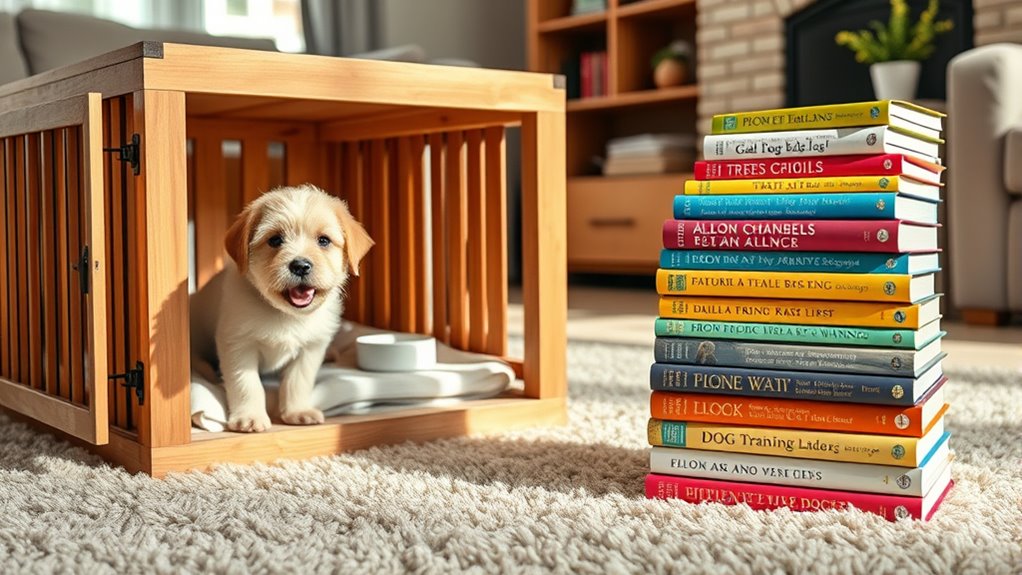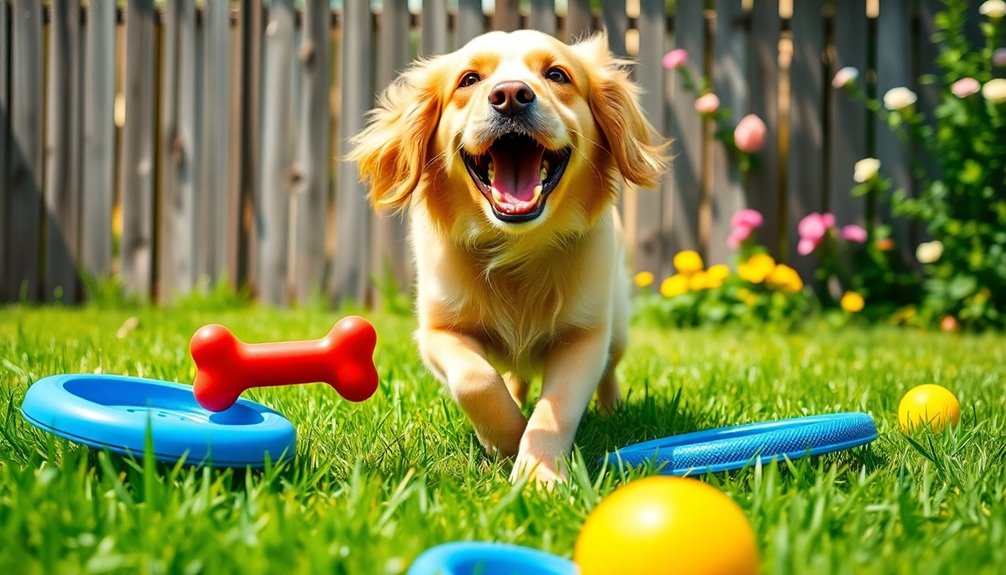If you’re looking for the best crate training books, I recommend exploring options that focus on kindness, positive reinforcement, and building trust with your puppy. The top titles offer step-by-step guidance, routines, and real-life success stories to help you create a calm, stress-free environment. Whether you’re new or experienced, these books can boost your confidence and improve your bond. Keep reading to discover effective techniques to make crate training smooth and enjoyable for both of you.
Key Takeaways
- Look for books emphasizing humane, positive reinforcement techniques that foster trust and reduce anxiety in puppies.
- Choose resources with clear, step-by-step routines tailored for puppies and adult dogs.
- Prioritize books that include real-life success stories and practical tips for overcoming crate resistance.
- Select guides offering comprehensive advice on crate selection, environment setup, and gradual acclimation.
- Ensure the book promotes compassionate training focused on kindness, confidence-building, and emotional well-being.
The Essential Guide to Positive Crate Training for Dogs and Puppies
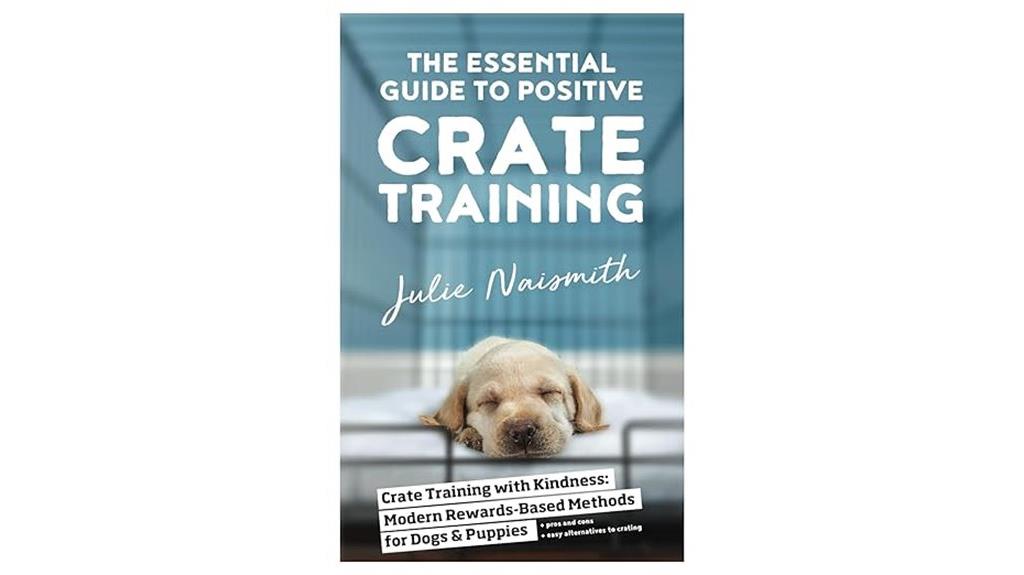
If you’re looking for a compassionate, effective approach to crate training, The Essential Guide to Positive Crate Training is an excellent choice. I found it helpful because it focuses on reward-based methods that promote kindness and confidence. The book offers practical steps to introduce your dog to the crate gradually, emphasizing patience and understanding. I appreciate how it encourages humane treatment, reducing anxiety and stress for my pet. While some sections feel superficial, the overall advice helped me reframe my approach and build trust. This book is a solid resource for owners who want gentle, effective crate training that prioritizes their dog’s well-being.
Best For: dog and puppy owners seeking a compassionate, reward-based approach to crate training that promotes kindness, confidence, and well-being.
Pros:
- Emphasizes humane, positive reinforcement methods that reduce anxiety and stress
- Provides clear, practical steps for gradual crate introduction and training
- Encourages understanding of individual dog needs to foster trust and confidence
Cons:
- Some sections may be superficial or lack in-depth technical details
- Certain parts of the book are considered repetitive or poorly written by some readers
- Critics note that the content may focus more on reasons not to crate train rather than effective training techniques
Puppy Training Book: Housebreaking, Potty & Crate Training
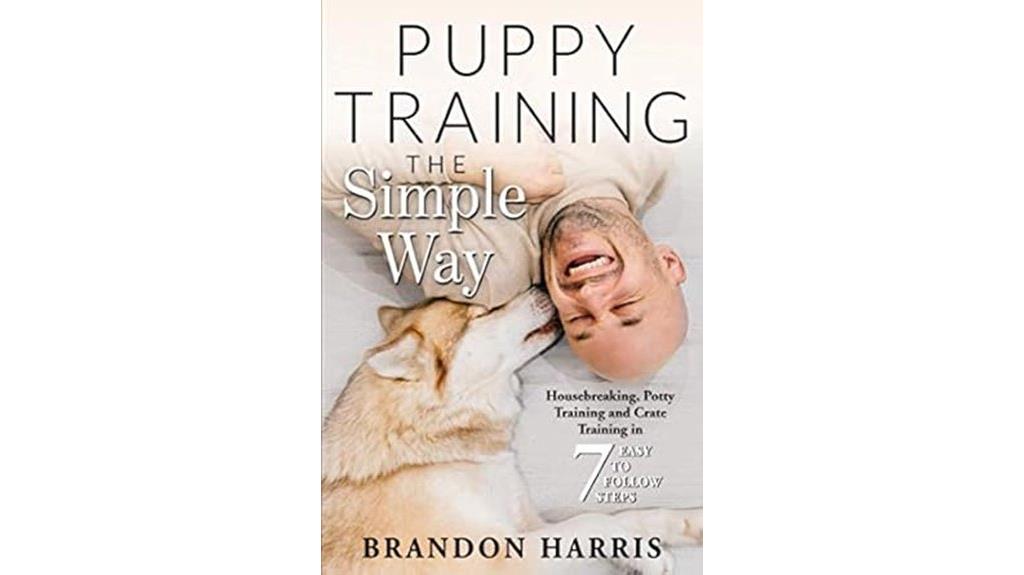
Puppy Training: Housebreaking, Potty & Crate Training is an excellent choice for new dog owners who want a straightforward, easy-to-follow guide to help their puppies develop good habits. This book breaks down the training process into seven simple steps, debunking myths and offering effective methods suitable for all ages. It’s practical, with clear instructions and a helpful glossary to clarify terminology, making it accessible for beginners. Many readers find it boosts their confidence, simplifies potty training, and encourages consistency. While it’s basic, it provides a solid foundation, especially when paired with additional resources for more advanced techniques.
Best For: new dog owners seeking a simple, beginner-friendly guide to housebreaking, potty, and crate training their puppies.
Pros:
- Clear, step-by-step instructions suitable for beginners
- Debunks common training myths and provides practical advice
- Includes a glossary that clarifies training terminology
Cons:
- May be too basic or simplistic for advanced training needs
- Some users find parts of the book hard to read or not detailed enough
- Might require supplementary resources like videos for more complex behaviors
Puppy Crate Training Tools Guide

The Puppy Crate Training Tools Guide stands out as an ideal resource for new puppy owners seeking a practical, step-by-step approach to crate training. It offers detailed instructions on introducing the crate, housebreaking, and handling common behavioral issues like barking and destructive chewing. The guide emphasizes creating a safe, positive environment through reward-based methods and patience. It provides a structured weeklong training plan tailored to different breeds and needs, highlighting the importance of early, consistent training. With real-life success stories and a compassionate tone, it helps owners build trust, foster good habits, and strengthen the bond with their puppy for long-term well-being.
Best For: New puppy owners and first-time raisers seeking a compassionate, practical, and research-backed guide to crate training and behavior management.
Pros:
- Provides a detailed, step-by-step training plan tailored to various breeds and needs.
- Emphasizes positive reinforcement and creating a safe, trusting environment.
- Includes real-life success stories and practical tips for long-term behavior and bond building.
Cons:
- May require patience and consistency from owners unfamiliar with crate training techniques.
- The comprehensive nature might be overwhelming for some new owners looking for quick solutions.
- Some breed-specific considerations may need additional tailored advice beyond the guide.
Puppy Training in 7 Easy Steps

Are you a first-time owner seeking a straightforward way to crate train your puppy? “Puppy Training in 7 Easy Steps” offers a clear, step-by-step approach that simplifies the process, making it perfect for beginners. This extensive guide covers all essential aspects of puppy raising, including housebreaking, socialization, and managing behaviors like nipping and separation anxiety. Its simple instructions and checklists make it easy to follow, helping new owners build a solid foundation for training. Highly recommended by breeders and owners alike, this book is an invaluable resource to ensure your puppy’s successful adjustment and happy, well-behaved future.
Best For: First-time puppy owners seeking a straightforward, easy-to-follow training guide to ensure their puppy’s successful adjustment and good behavior.
Pros:
- Clear, step-by-step instructions suitable for beginners
- Includes practical checklists for socialization, housebreaking, and crate training
- Highly recommended by breeders and new owners for its simplicity and effectiveness
Cons:
- Primarily focused on puppies around 8 weeks old, less comprehensive for older dogs or rescue cases
- May require adjustments for training in regions outside of the U.S., such as the UK
- Does not cover advanced training or behavior modification techniques for more challenging behaviors
The Essential Guide to Positive Crate Training for Dogs and Puppies
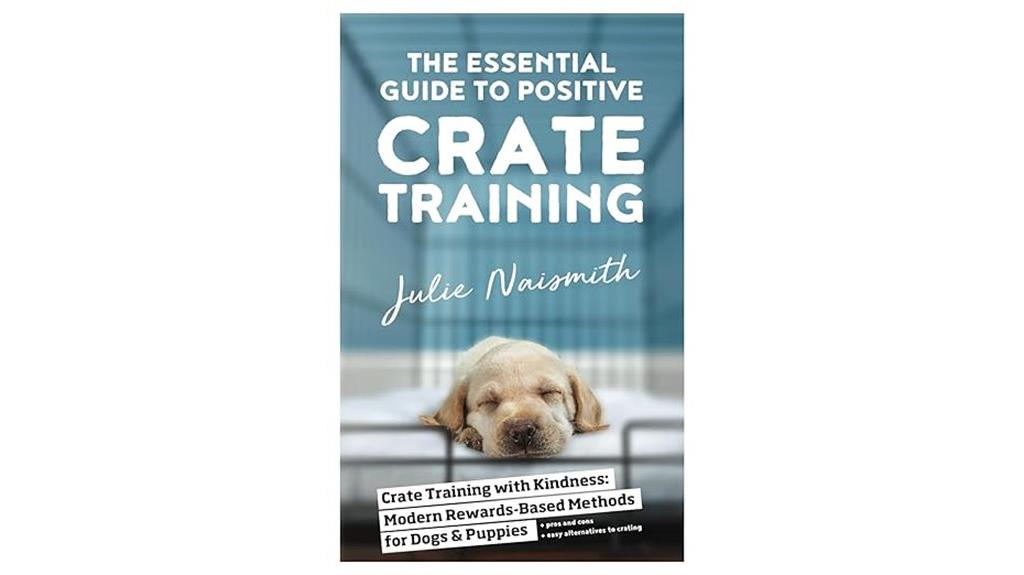
If you’re seeking a compassionate, easy-to-follow approach to crate training your dog or puppy, “The Essential Guide to Positive Crate Training” stands out as an ideal resource. This book emphasizes reward-based methods, focusing on kindness, patience, and understanding. It offers practical steps to introduce the crate gradually, helping dogs feel safe and confident. Many owners find it reduces separation anxiety and destructive behavior, making crate training a positive experience for both pet and owner. While some critique its depth, the accessible advice and humane techniques make it a valuable guide for those wanting to foster trust and well-being in their dogs.
Best For: dog and puppy owners seeking a compassionate, reward-based approach to crate training that emphasizes kindness, patience, and trust-building.
Pros:
- Emphasizes humane, reward-based methods that foster trust and confidence in dogs
- Provides practical, easy-to-follow steps for gradual crate introduction
- Helps reduce separation anxiety and destructive behaviors through positive reinforcement
Cons:
- Some readers find the content lacks depth and detailed training techniques
- Certain sections are repetitive or poorly written, affecting readability
- Critics feel the book may be superficial or not sufficiently credible for advanced training needs
How to Raise the Perfect Dog: Through Puppyhood and Beyond
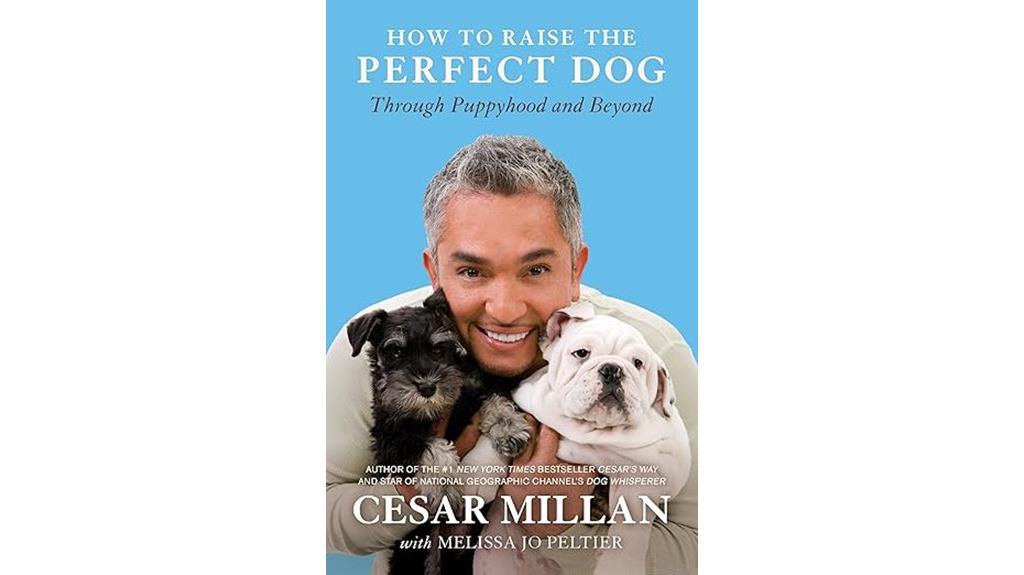
For dog owners seeking a thorough guide that combines practical techniques with a balanced philosophy, “How to Raise the Perfect Dog: Through Puppyhood and Beyond” stands out as an excellent resource. This book offers clear, step-by-step instructions, drawing from Cesar Millan’s experience and expert insights. It covers essential topics like crate training, feeding, vaccinations, and socialization, making it perfect for both beginners and seasoned handlers. The approach emphasizes understanding dog psychology, calm leadership, and patience, resulting in well-behaved, happy dogs. I found it invaluable for steering through common challenges and building a strong, trusting bond with my puppy.
Best For: dog owners of all experience levels seeking practical, balanced advice on raising a well-behaved, confident dog from puppyhood onward.
Pros:
- Offers clear, step-by-step guidance rooted in dog psychology and leadership principles.
- Combines practical techniques with a positive, humane approach to training.
- Provides insights and real-life examples that help address common challenges and build trust with your puppy.
Cons:
- Some critics may find Cesar Millan’s methods too strict or outdated for modern training preferences.
- The emphasis on calm-assertive energy may be challenging for owners unfamiliar with energy-based training techniques.
- The book requires consistency and patience, which might be difficult for owners seeking quick results.
Zak Georges Dog Training Revolution

The Zak Georges Dog Training Revolution stands out as an ideal resource for dog owners who prioritize humane, positive methods over outdated dominance techniques. Zak’s approach focuses on building trust and fostering a strong bond through gentle, reward-based training. His step-by-step techniques cover everything from basic commands to addressing common behavioral issues, with the added benefit of video tutorials for visual learners. Owners report rapid progress and happier, more obedient dogs. Unlike traditional dominance methods, Zak’s methods promote understanding canine behavior and emotional well-being. This all-encompassing, compassionate approach makes training more effective and enjoyable for both dogs and their owners.
Best For: dog owners seeking humane, positive reinforcement training methods that foster trust, bond-building, and effective obedience.
Pros:
- Emphasizes gentle, reward-based techniques that promote emotional well-being and trust
- Provides clear, step-by-step instructions complemented by helpful video tutorials
- Produces rapid, lasting results in training commands and behavioral issues
Cons:
- May require patience and consistency, which can be challenging for some owners
- Less suitable for owners looking for quick, punishment-based solutions
- The effectiveness can vary depending on the dog’s breed and individual temperament
Dog Training for Kids: Fun and Easy Ways to Care for Your Furry Friend

Dog training for kids can be both fun and rewarding, especially when guided by the right resources. This book is perfect for children aged 7 and up, as well as families and caregivers, encouraging kids to take ownership of their pup’s training. It offers clear, step-by-step instructions, engaging visuals, and a variety of tricks, games, and routines. The well-organized content promotes responsibility and bonding, making training practical and enjoyable. Its simple language and helpful safety tips empower kids to confidently care for their furry friends while building skills that last a lifetime. It’s an excellent gift that turns training into a positive, shared experience.
Best For: kids aged 7 and older, families, and caregivers seeking an engaging, structured, and practical guide to dog training that fosters responsibility and bonding.
Pros:
- Clear, step-by-step instructions with visual aids make training accessible for young learners.
- Well-organized content with sections on commands, tricks, and troubleshooting aids easy navigation.
- Encourages responsibility and ownership, boosting kids’ confidence and fostering a positive bond with their dogs.
Cons:
- May have limited coverage on complex behavioral issues like biting or nipping.
- Uses American English, which might be less familiar to some international readers.
- Small print in thicker editions could be challenging for younger children to read comfortably.
Crate Training Puppies Guide

Are you a new puppy owner feeling overwhelmed by how to start crate training effectively? I’ve found that having a clear, step-by-step guide can make all the difference. This book offers practical advice for beginners, including a structured 7-day plan perfect for busy schedules. It covers essentials like choosing the right crate, breed-specific tips, and creating positive associations. While some may find it a bit surface-level, I appreciate its straightforward approach, especially for teething puppies or early training. Overall, it’s a useful resource for building a safe, comfortable crate routine that sets your puppy up for success.
Best For: new puppy owners seeking a straightforward, easy-to-follow crate training plan that fits into a busy schedule.
Pros:
- Clear, step-by-step 7-day training schedule suitable for beginners.
- Covers essential topics like crate selection, breed-specific needs, and positive associations.
- Friendly and concise writing style that makes complex concepts easy to understand.
Cons:
- Some users find the content to be superficial and lacking in-depth guidance.
- Occasional typos and grammatical errors due to poor editing.
- Repetitive information that may not provide much new insight for experienced owners.
How to Crate-Train a Puppy: The Ultimate Guide
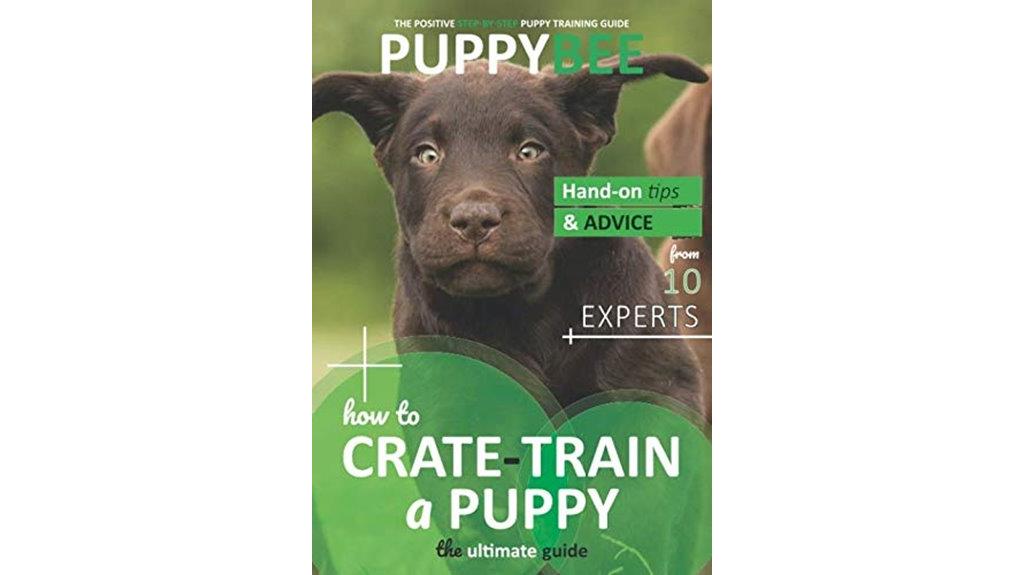
If you’re looking for a clear, practical guide to crate training your puppy, “How to Crate-Train a Puppy: The Ultimate Guide” is an excellent resource, especially for those who want straightforward advice from experienced trainers. This well-organized book offers concise, actionable tips and covers all aspects of crate training. Its balanced perspective considers multiple opinions, making it useful for both beginners and seasoned dog owners. Despite being somewhat pricey, the depth of information and practical approach make it a worthwhile investment. Readers praise its clarity and helpfulness, finding it a reliable guide to successfully crate train their puppies.
Best For: new puppy owners and experienced dog owners seeking a straightforward, comprehensive guide to crate training.
Pros:
- Well-organized and easy to follow, making it accessible for all experience levels
- Provides practical, actionable tips from experienced trainers
- Offers a balanced perspective, considering multiple opinions and methods
Cons:
- Slightly expensive compared to other training guides
- Focused specifically on crate training, may not cover broader puppy training topics
- The concise format might lack in-depth explanations for some readers
Crate Training for Puppies: Step-by-Step Guide
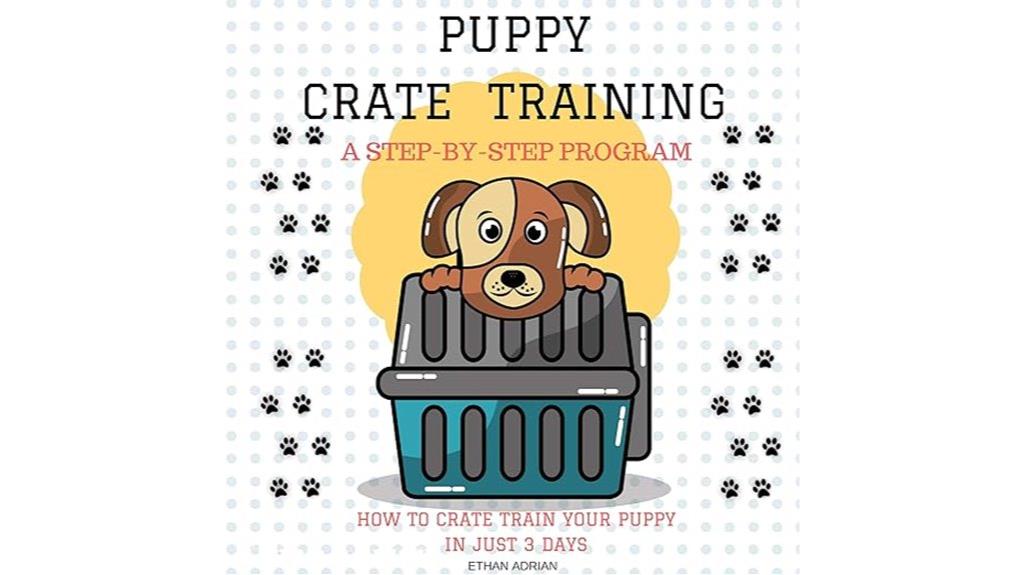
For new puppy owners seeking straightforward guidance, “Crate Training for Puppies” offers a clear, step-by-step approach to introducing and using crates effectively. The book covers selecting the right crate, gradually introducing it with positive reinforcement, and establishing routines. It includes practical advice for managing crate time, preventing accidents, and reducing puppy anxiety. While some readers find the instructions easy to follow and helpful, others note contradictions, especially regarding crate use for discipline and water placement. Overall, it’s a practical resource for beginners, but I recommend supplementing it with evidence-based, humane training methods to ensure your puppy’s well-being.
Best For: new puppy owners seeking straightforward, step-by-step guidance on crate training and building a trusting relationship with their dog.
Pros:
- Easy-to-follow, beginner-friendly instructions that simplify crate training techniques.
- Provides practical advice on crate selection, routine establishment, and managing puppy anxiety.
- Offers a comprehensive overview that covers essential aspects of housetraining and behavior management.
Cons:
- Contains contradictions regarding crate use for discipline and water placement, which may cause confusion.
- Some advice may be outdated or not fully aligned with evidence-based, humane training practices.
- The content can be repetitive and lacks in-depth coverage of alternative or advanced training methods.
The Essential Guide to Positive Crate Training for Dogs and Puppies

The Essential Guide to Positive Crate Training stands out as an ideal resource for dog owners who prioritize humane, reward-based methods. I appreciate how it emphasizes kindness, confidence, and well-being over punishment. The book provides practical, straightforward steps for introducing crates, choosing the right space, and creating a comfortable environment. I found Julie’s expertise especially helpful for addressing separation anxiety and reducing destructive behaviors. While some criticize it for overemphasizing negatives or including repetitive content, I believe its focus on positive reinforcement makes it a valuable tool for fostering trust and confidence in your dog. It’s a compassionate approach I highly recommend.
Best For: dog owners who prioritize humane, reward-based training methods and seek practical guidance to foster confidence and well-being in their pets.
Pros:
- Emphasizes kindness, positive reinforcement, and confidence-building strategies.
- Offers clear, straightforward steps suitable for both puppies and adult dogs.
- Provides valuable insights for addressing separation anxiety and reducing destructive behaviors.
Cons:
- May overemphasize negatives or include repetitive content, leading to perceived redundancy.
- Some readers find the writing style to be poorly constructed or lacking originality.
- Contains content from other sources, which might be seen as unnecessary or diluting the main message.
Quick & Easy Crate Training

Looking for a straightforward guide to help your puppy adapt quickly to crate training? I found that the book offers practical, easy-to-follow advice that really works. It covers selecting the right crate, introducing your pup gradually, and establishing routines that promote calmness. Techniques like using toys and blankets help puppies settle faster, while keeping departures low-key reduces anxiety. Many owners shared success stories, like their dogs naturally going into crates or sleeping peacefully alone. Although it doesn’t address every issue, this guide provides the essential tools to start crate training confidently, making the process quicker and less stressful for both of you.
Best For: new dog owners seeking a simple, effective guide to crate training that builds confidence and promotes quick adaptation for puppies.
Pros:
- Provides clear, practical steps for crate selection and introduction
- Offers easy-to-follow routines that reduce puppy anxiety and promote calmness
- Includes success stories that motivate and reassure owners about positive outcomes
Cons:
- Does not cover solutions for issues like barking, biting, or crate resistance
- May suggest long crate durations that could be unsuitable for some puppies or dogs with emotional needs
- Lacks detailed guidance for crate training older dogs or addressing specific behavioral challenges
Be Right Back! Guide to Overcoming Dog Separation Anxiety
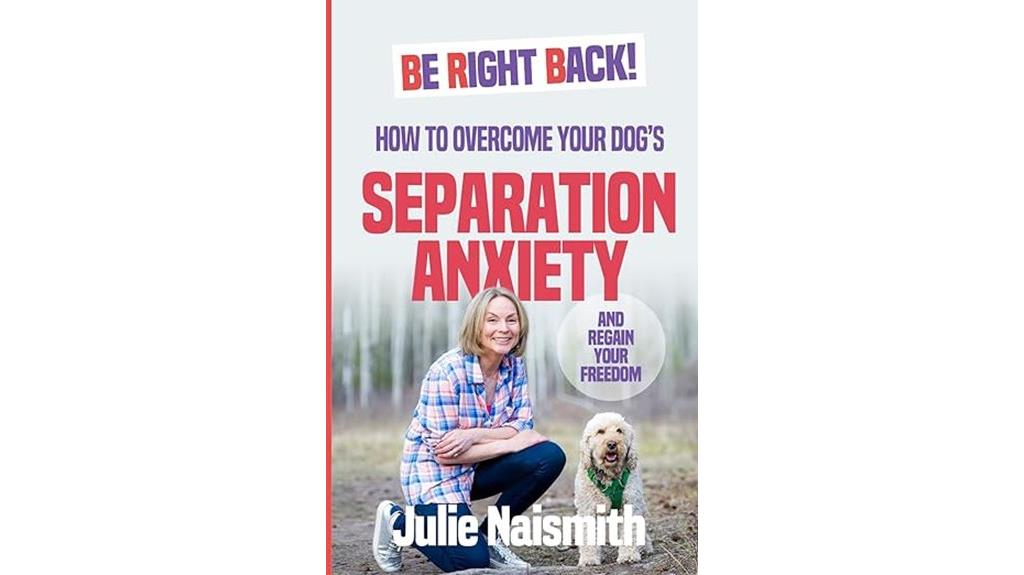
If you’re struggling to help your dog cope with separation anxiety, “Be Right Back!” offers a compassionate, realistic approach. It emphasizes gradual desensitization, slowly increasing time apart, and tracking progress without overthreshold triggers. The book warns against quick fixes like strict contracts or stuffing Kongs, which often worsen the problem. Support from veterinarians, community groups, and journaling can boost your efforts. Patience and consistency are essential, as progress may take weeks or months. The guide also discusses medication cautiously, encouraging professional advice. Most importantly, it reassures owners that, with dedication, dogs can overcome anxiety and become more confident and independent.
Best For: Dog owners seeking a compassionate, step-by-step guide to gradually overcome separation anxiety through realistic training, support, and patience.
Pros:
- Emphasizes gradual desensitization and realistic progress tracking.
- Encourages community support and owner accountability.
- Provides practical, compassionate advice from a fellow dog owner’s perspective.
Cons:
- Requires patience and consistency, which may be challenging for some owners.
- Progress can take weeks or months, not quick fixes.
- Cautiously discusses medication, emphasizing the need for professional guidance due to potential side effects.
Factors to Consider When Choosing a Crate Training Book

When choosing a crate training book, I consider the training approach it emphasizes to guarantee it aligns with my goals. I also look at whether it addresses my dog’s age and breed, as different needs require different strategies. Finally, I prioritize clear, practical techniques and a style that makes the information easy to follow.
Training Approach Emphasis
Choosing the right crate training book depends heavily on the approach it promotes. I recommend looking for books that emphasize positive reinforcement and humane, reward-based methods. These guides focus on building trust and confidence, avoiding harsh confinement or punishment. They often include step-by-step routines that are gentle and stress-free, making them ideal for dogs with separation anxiety or sensitive temperaments. Additionally, books that prioritize kindness usually highlight creating a cozy, safe environment inside the crate to foster positive associations. I find that resources emphasizing compassionate techniques stress patience and understanding, which are essential for success. Selecting a book with this approach ensures your puppy feels secure and loved throughout the training process, leading to more effective and enjoyable crate training for both of you.
Age and Breed Focus
Selecting a crate training book that aligns with your dog’s age and breed guarantees the advice is practical and effective. Different books focus on specific needs, whether you’re working with a puppy, an adult, or a particular breed. Breed characteristics like size, energy level, and temperament influence the best crate type and training methods. For puppies, guides often address developmental stages, like teething or independence, to help you navigate early training. Small breeds prone to separation anxiety may require a different approach than large, high-energy breeds that need more exercise and space. Choosing a book tailored to your dog’s age and breed ensures the strategies are relevant, increasing the chances of successful crate training and a happy, well-adjusted pet.
Practical Techniques Provided
Practical techniques are the backbone of effective crate training books, as they provide clear, actionable steps that guide you through each stage of the process. You want methods that emphasize positive reinforcement, gradual desensitization, and creating a safe space for your dog. Good resources give specific instructions on selecting the right crate size, proper placement, and establishing routines that build your dog’s confidence. They also address common behavioral issues like separation anxiety, destructive chewing, and barking, offering proven solutions. The best books include adaptable strategies tailored to various breeds, ages, and individual needs, ensuring humane and effective training. Clear techniques help you stay consistent, confident, and focused as you guide your puppy towards success.
Tone and Style Clarity
Have you ever struggled to follow a training book because its instructions felt confusing or overly technical? A clear tone and style make a huge difference, helping you understand and implement techniques without frustration. When a book uses approachable language and a compassionate tone, it builds trust and encourages positive reinforcement, which is essential for humane crate training. Clarity in the writing means you can grasp key concepts and steps quickly, making the process more efficient. Well-structured guidance, like step-by-step instructions and concise explanations, boosts your confidence and helps you remember what to do. Ultimately, a straightforward, respectful tone promotes a positive mindset, making crate training less stressful and more enjoyable for both you and your puppy.
Depth and Detail Level
When choosing a crate training book, it’s important to contemplate how much depth and detail it offers. A good book should go beyond basic tips and provide thorough, in-depth training techniques suited to your experience level. Look for content that covers crate selection, placement, and gradual training steps with detailed explanations. It’s also helpful if the book discusses potential challenges and pitfalls, so you’re prepared for obstacles. I prefer books that balance practical instructions with scientific or behavioral insights, giving me a nuanced understanding of crate training. Consider whether the level of detail matches your needs—whether you’re a beginner or looking for advanced troubleshooting. A well-detailed book ensures you have all the information needed to train your puppy effectively and confidently.
Ethical Training Methods
Choosing a crate training book that emphasizes ethical methods guarantees you prioritize your dog’s well-being and foster a trusting relationship. Ethical training focuses on positive reinforcement, rewarding calm behavior instead of punishment or harsh techniques. Reputable books advocate for creating a safe, comfortable environment, avoiding long or stressful confinement. They emphasize gradual, voluntary acclimation, respecting your dog’s pace and comfort levels. Evidence-based approaches discourage the use of tools like shock collars or forced confinement that can cause harm or fear. Instead, these resources guide you on addressing behavioral issues compassionately, building trust and understanding. By choosing a book rooted in humane principles, you ensure your training methods promote your dog’s emotional and physical health, leading to a more positive and effective crate training experience.
Frequently Asked Questions
How Early Should I Start Crate Training My Puppy?
Starting crate training early is key, and I recommend beginning as soon as you bring your puppy home, around 8 weeks old. Early introduction helps your pup feel safe and builds positive associations with the crate. I suggest keeping sessions short and positive, gradually increasing time. Consistency is vital, so I make sure to use the crate regularly, turning it into a comfy, secure space for my puppy.
What Size Crate Is Best for My Dog’S Age and Breed?
When choosing a crate size, I consider my dog’s age and breed. For puppies, I opt for a crate that’s big enough to stand, turn around, and lie down comfortably, but not so large they can eliminate in one corner. As they grow, I gradually upgrade to a larger crate. For adult dogs, I pick a size that allows them to stretch out comfortably without extra space, promoting good behavior.
How Long Should Crate Training Sessions Last?
Many worry crate training will be uncomfortable for their puppy, but it’s actually a gentle process. I recommend starting with short sessions, around 5 to 10 minutes, and gradually increasing as your pup gets comfortable. For older dogs, sessions can be longer, about 30 minutes to an hour. Always observe your puppy’s mood and never force them, making crate time a positive experience.
Can Crate Training Help With Dog Separation Anxiety?
Crate training can definitely help with dog separation anxiety. I’ve seen it work because it creates a safe space where your dog feels secure. When done gradually, it helps reduce stress and prevents destructive behaviors when you’re not around. I always recommend pairing crate training with positive reinforcement, like treats and praise, so your pup associates the crate with good experiences instead of fear.
Are There Specific Crate Training Methods for Puppies With Special Needs?
When it comes to crate training puppies with special needs, I’ve found that tailored approaches work best. I focus on gentle, slow introductions, ensuring the crate is a safe space. I also adapt techniques based on their specific requirements, like shorter sessions or extra comfort items. Patience is key, and I always prioritize their well-being. Every pup is unique, so I customize my method to support their individual needs and help them thrive.
Conclusion
If you’re serious about transforming your puppy into a well-behaved, happy family member, these books are your secret weapon. They’ll turn what feels like chaos into a smooth, joyful journey—faster than you can say “potty trained!” Remember, patience and consistency are your best friends. Immerse yourself in these guides, and watch your puppy thrive like a superstar in the making. Your perfect pup is just a page away!

